The independent contractor agreement is one of the most common contracts seen in business today. We will see even more of them as the labor market changes, which means we really need to get them right. In this episode of the Contract Teardown Show, we shine a light on the deceptively simple independent contractor agreement.
Questions in this Episode
- Is an assignment of inventions clause always needed?
- What risks are created by incorporating outside documents by reference?
- Should an independent contractor agreement treat the parties as equal, or is it by nature one-sided?
- How can managers undermine the purpose of an independent contractor agreement?
Red Lion Hotels
The same agreement in this Teardown episode comes from Red Lion Hotels. It stands out specifically because it doesn’t stand out. These agreements have become so common that you could almost pick one out of a Law Insider hat and it would be substantially similar to every other option.
This particular agreement is made between the hotel chain and a former executive. The executive intends to support the company as it attempts to attract potential franchisees.
As with most of these agreements, many words are spent trying to distance the company and the contractor. According to tech startup attorney Hebe Doneski, this creates an often one-sided, overly-wordy document.
Where’s the Assignment of Inventions?
Doneski first pointed out what wasn’t in the document: an assignment of inventions clause.
Particularly in her context—small technology companies—the creation of intellectual property has enormous value. No contractor agreement would be complete without deciding how to assign those IP rights among the parties.
In this case of an executive doing relationship work, we don’t see an assignment of inventions clause. Still, although IP is not as fundamental to the role, it’s easy to imagine this former executive creating business processes or promotional language that have long-term value to the company or to himself. A hotelier’s principal value is in real estate, obviously, but business processes could be what differentiates one brand from another.
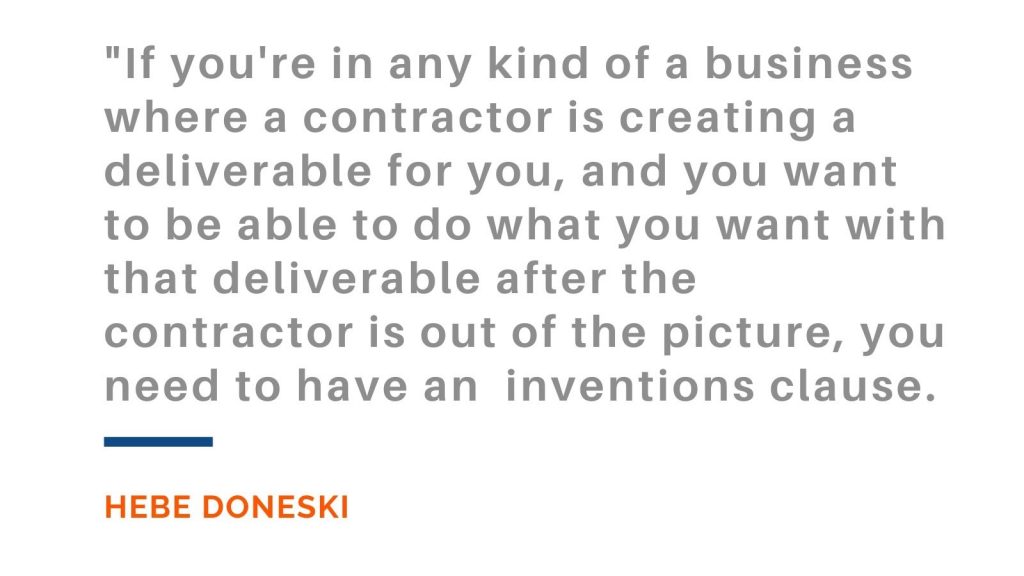
Always include an assignment of inventions clause in an agreement like this.
This is especially relevant when dealing with parties outside the United States. The American “work for hire” doctrine is unusual. Assuming you can rely on that doctrine to assign unclear IP rights will leave you in the lurch. Instead, be clear in your agreement how such rights should be distributed among the parties.
The Risks of Incorporating by Reference
As is often true, this agreement references other documents outside the agreement. But, according to Hebe, it does so far too casually.
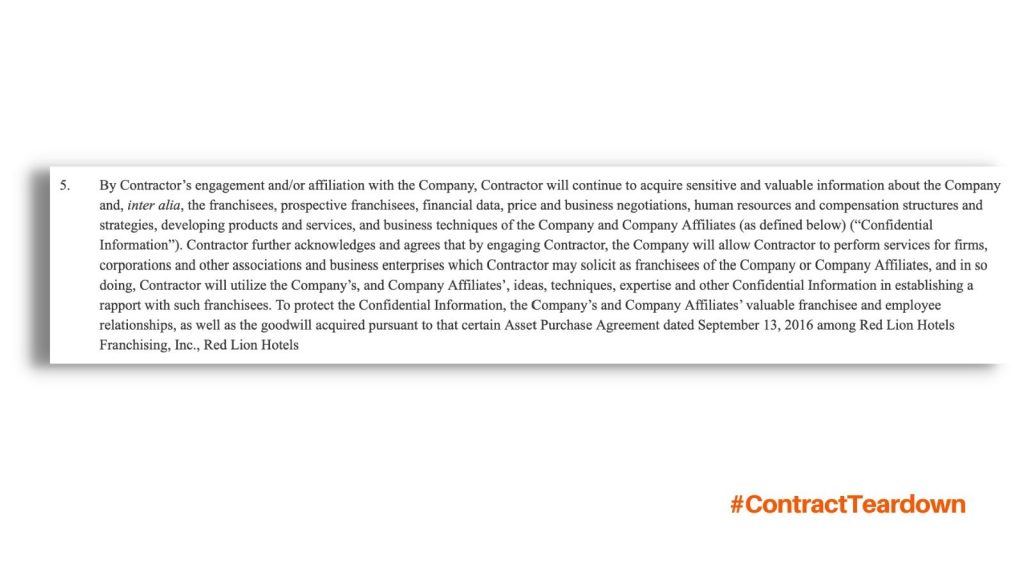
The referenced document is short—short enough to have included it as an exhibit. It’s a pretty standard non-solicitation and non-competition covenant wedged inside a larger policy document. The trouble comes, according to Hebe, when it speaks to the length of the agreement.
According to the outside document, the covenants won’t extend beyond three years. This matters because courts have historically found long-term covenants unenforceable. But the actual contractor agreement has language that extends the agreement indefinitely. That puts the agreement at risk.
If you need to incorporate outside documents into your agreement, tread lightly. Especially if your agreement can be undermined by conflicting language (which is almost always true). When you do incorporate outside documents, consider adding them as exhibits to the agreement so it’s clear to everyone which version is being incorporated.
This Non-Disparagement Clause is Expansive for One Party
Hebe repeatedly furrowed her brow at how one-sided this contractor agreement is. Frankly, many such agreements are designed to give power to the hiring company. But these agreements need not always serve the function of disempowering a worker. This agreement’s non-disparagement clause provides an example.
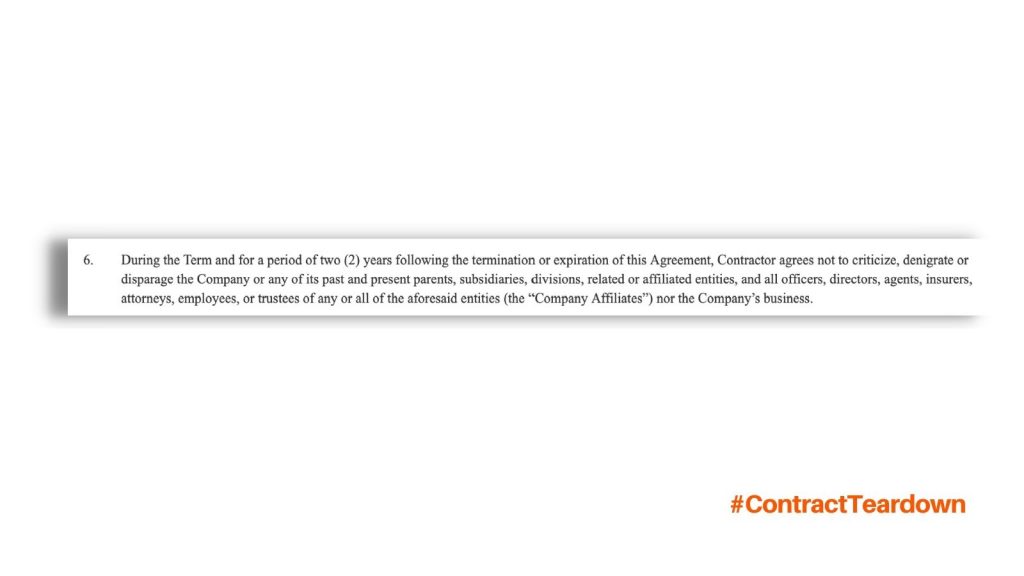
As Hebe pointed out, the non-disparagement language clearly and severely limits the contractor. The language is clear. It covers a large swath of potential harms. In short, the contractor can’t say a negative word about the company. In an age of social media channels that make it easy to publicly criticize, this kind of clarity makes sense.
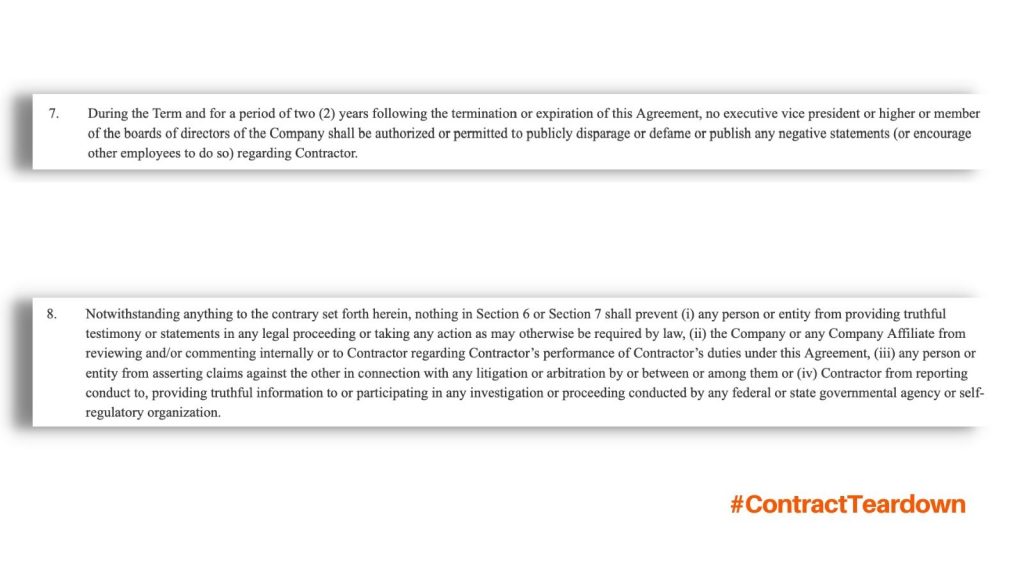
But comparing the language that limits the contractor to the language that limits the company, you see incredible disparity. The section that protects the company is thick and bullet-proof; the section that protects the contractor is thin and provides clear loopholes.
For Hebe, agreements like this are designed to connect two independent and empowered companies. When sections of an agreement are so clearly lopsided, this creates tension in the relationship before it’s even started.
Ending the Agreement Should Reflect Reality
Another clause that raised Hebe’s eyebrows was the termination for cause section.
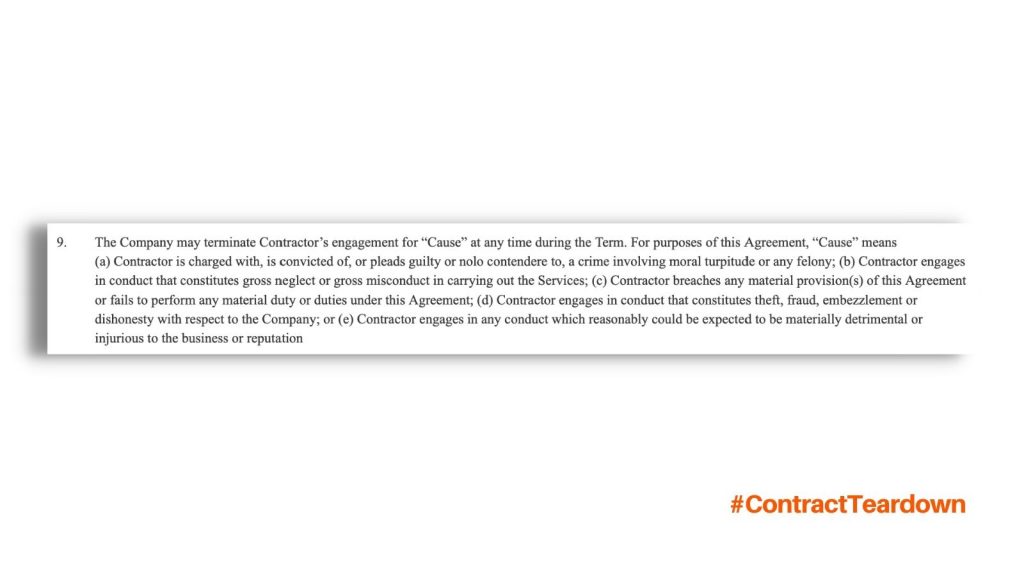
In short, she questioned the company’s requirement that the contractor cure harms that are incurable. For example, the agreement says that the contractor cannot engage in theft, fraud, or embezzlement; and if he does, he must cure the harm to preserve the relationship.
As Hebe pointed out, curing embezzlement would require some real magic. Why include the curing provision to preserve the agreement? At that level of harm, it makes sense to simply terminate the relationship. Such harms clearly justify the termination for cause.
Indemnifications Show the Relative Power of the Parties
Another section that revealed the uneven power relationship between the parties came in the indemnification clause.
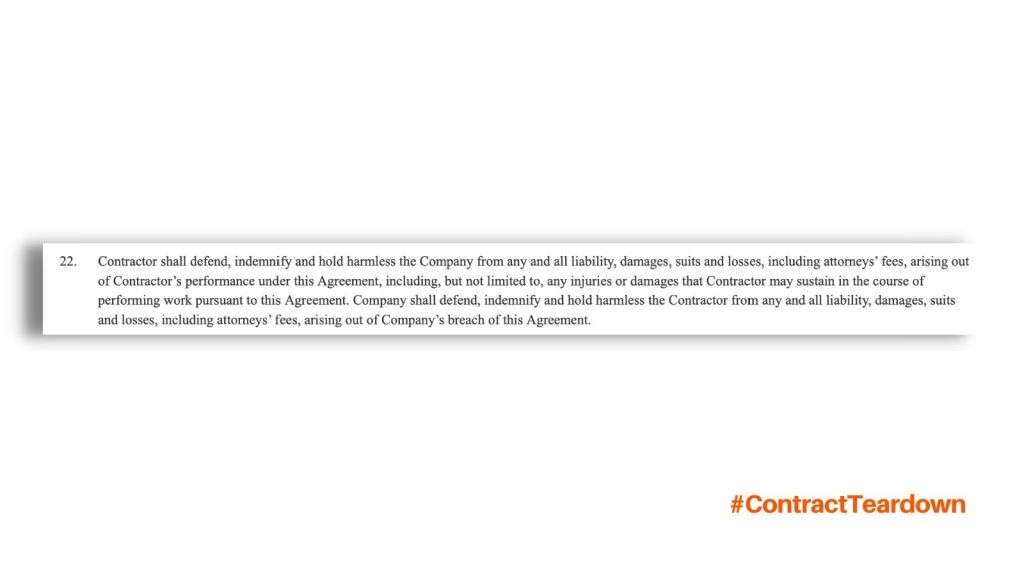
This agreement is by its nature a contract between a large company and an individual acting as a company. As Hebe put it, no human has enough insurance to indemnify a company, so why include that requirement?
Particularly troubling is the company’s expectation that the contractor indemnify the company over its classifying him as a contractor. The contractor doesn’t control compliance with that designation. The company’s treatment of the former executive is what will determine whether a court would deem him a contractor rather than an employee. In that reality, how could the contractor be expected to bear the risk of a misclassification?
Any indemnification section should consider the relative power and control of the parties to the agreement.
Are we Overusing the Term “Contractor”?
Stepping back to the larger social context, Hebe questioned how the contractor relationship works in practice rather than on paper.
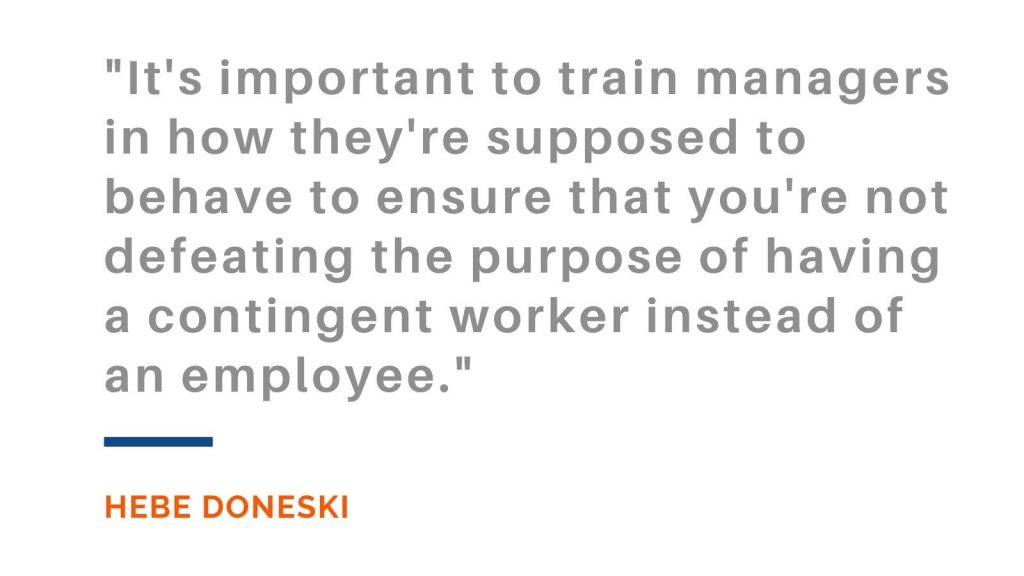
In this agreement, Hebe identified ten sections that include some version of “Hey, this is a contractor.” These sections attempt to clarify what’s in practice a very muddy labor relationship. Do these clauses even work?
As any employment lawyer would tell you, using words in an agreement won’t negate what happens in the real world. A true counselor will make clear to a company that daily life will define whether there is a contractor relationship. Managers on the ground must be informed and educated about the power contractors have. They represent independent companies of one and must be treated that way.
Although this agreement is fairly readable, don’t use independent contractor agreements without a plan for compliance follow-up.
These relationships are becoming more and more common. So make sure courts will respect them by creating systems and training that respect them as well.
Show Notes
THE CONTRACT: Red Lion Hotels Corp’s Independent Contractor Agreement
THE GUEST: Hebe Doneski is the founder of 108 Legal, helping companies accelerate growth through contract transformation, high stakes deal negotiation, new market expansion, and more.
THE HOST: Mike Whelan is the author of Lawyer Forward: Finding Your Place in the Future of Law and host of the Lawyer Forward community. Learn more about his work for attorneys at www.lawyerforward.com.
If you are interested in being a guest on Contract Teardown, please email us at community@lawinsider.com.
TRANSCRIPT
Hebe Doneski [00:00:00] The contractor is out of the picture, you need to have your assignment at inventions clause.
Intro Voice [00:00:05] Welcome to the Contract Tearddown Show from Law Insider, where legal experts tear down contracts from some of the most well-known companies and high profile executives around the world.
Mike Whelan [00:00:18] In this episode, Tech Company Council Hebe Doneski tears down an independent contractor agreement from Red Lion Hotels. This agreement stands out specifically because it doesn’t stand out. It’s pretty typical for an engagement for work that’s becoming more and more common. We talk about the assignment of inventions, use of confidential information, incorporations by reference, and big picture shifts in the nature of work. So let’s tear it down. Hey, everybody. Welcome back to the Contract Teardown show. I’m Mike Whalen. The purpose of the show is to do exactly what it sounds like. We take contracts, we beat them up. We do it with smart friends like my friend Hebe over here. Hebe, how are you doing today?
Hebe Doneski [00:01:01] I’m well, thanks, Mike. How are you?
Mike Whelan [00:01:03] Pretty good. Hebe Doneski. We are talking about a document as we do. It is this document. It’s an independent contractor agreement. And if you guys look at this, you can tell it’s coming from Law Insider so you’ll see links on here to similar language to other places. It’s a really cool resource. I appreciate Hebe for finding one on here. And we’re going to talk about some of this information. It’s filed in an SEC 8-K 8-K filing, which is where you’ll find this kind of thing. So Hebe, why are we talking about this particular document? When does it come up in practice?
Hebe Doneski [00:01:36] Well, I would say next to the non-disclosure agreement, independent contractor agreements are really kind of the lifeblood of any business. They’re the most common agreement you’re going to see in pretty much any kind of commercial practice. So I wanted to tear down this particular independent contractor agreement with Red Lion Hotels, and I think we’ll have fun doing it.
Mike Whelan [00:01:55] And like NDAs, they’re usually pretty crappy. So we’re going to go through this thing and talk about it. Hebe, as we do, why you why are we talking to you? Tell me about your background, your practice, where what you’re doing in life.
Hebe Doneski [00:02:08] Sure. So I started a practice recently representing tech companies as they grow typically zero to sort of one hundred million in revenue companies that are too small to have lawyers in-house. And I help them with everything they need, including a lot of these independent contractor agreements.
Mike Whelan [00:02:24] Indeed, there’s a whole economy being built on independent contractor agreements, which is a sort of a huge social mess. And we’ll talk about that later. But first, let’s get into particular language as we do. We’re going to go down through these different sections before we get started with that. I know there was a background thing that was missing in this that smacked you upside the head. Tell me what was missing in this document just to start with and why it’s driving you crazy.
Hebe Doneski [00:02:49] Yeah, well, the thing that really jumped out at me in this is there’s no assignment of invention’s language. There isn’t the customary work for hire clause that you would expect to see. And in the tech world where I live, that’s the most important part of the agreement. The reason you sign an independent contractor agreement typically is to ensure the company that you can do whatever you want with the deliverables that the contractor makes for you. Now, in this particular agreement, that probably isn’t a huge problem, because if you look at the scope of work, what the contracts are doing is primarily sort of shaking hands and kissing babies and using his network to get hotels to sign up as franchisees. But if you’re in any kind of a business where a contractor is creating a deliverable for you, whether that is source code, whether it’s ad copy, whether it’s content logos, any type of deliverable, and you want to be able to do what you want with that deliverable after the contractor is out of the picture. You need to have your assignment, the inventions clause.
Mike Whelan [00:03:49] Right. And certainly in that scope of work, you could imagine somebody coming up with a cool idea for how to do this thing better. And who owns that idea after.
Hebe Doneski [00:03:58] Yeah, and it’s it’s the contractor as this as this contract is written. So that jumped out at me as a pretty glaring omission and just kind of a parenthetical on the assignment of invention/work for hire concept. Something I see companies most often is if you are working with a contractor or a company who’s overseas, typically our work for hire doctrine is really an American concept. Most countries don’t recognize it. And so you can get to the same place. But in most countries, IP rights aren’t assignable. So you really need to take a careful look at that particular provision. If you’re dealing with a contractor who is not in the US, I’ve even seen companies overseas that sort of grabbed a US centric contractor agreement and had that work for hire clause in it and even they didn’t realize it was going to be completely unenforceable where they work.
Mike Whelan [00:04:49] Good note. Let’s go down to what is in here. We’re going to jump down to number five, a fairly long section it’s talking about. By your engagement or affiliation, you’re going to agree to other things, it talks about the sensitive and valuable information, there’s definitions for confidential information in there, as you typically see in these kinds of agreements. But it also says that there are other certain sellers listed on the signature pages there, too, as amended the purchase agreement. It starts to reference other documents, restrictive covenants. What do you think about documents like this that are meant for this relationship? Is incorporating these other things by reference and just talking about them? Is that the right way to go with this kind of document?
Hebe Doneski [00:05:33] I think in this case, they did themselves a disservice by referencing this external document when you when you pull this asset purchase agreement and you look at Section six point seven, it’s just a non solicitation and non-competition covenant. It’s not very long less than a page. And so I think if I had this to do over again, I would have taken a look at that and added it maybe as an exhibit, because what they missed, I think, was they created a potential ambiguity. So this non solicitation and non-competition covenant was supposed to last for three years after the closing of this particular M&A transaction, and that three year period would have expired sometime towards the end of this independent contractor agreement. But what they’ve done, if you take a look at the last sentence of this paragraph, the provisions of the Section five survive any termination or expiration of this agreement. So the contractor is bound by these covenants. Is he now bound forever? I think that by copying and pasting that provision into an exhibit or into the agreement, hopefully the drafter would have noticed the potential for creating that ambiguity and would have been able them to close that gap to to not not potentially cause that that not solicitation covenant now to last forever and an assertion about a law which controls this agreement. But we all know that in most cases, the longer a non-competition clause is, the less likely it is to be enforceable. So not only have they created a potential problem for the contractor here who may want to compete somewhere down the road, the company is potentially created a problem for themselves by making that that non-competition covenant unenforceable, by making it too long.
Mike Whelan [00:07:26] Hey, everybody, I’m Mike Whalen, I hope you’re enjoying this episode of the Contract Teardown Show. Real quick, I want to ask you to do me/you really a quick favor. Look down below. You’ll see a discount code to join the law insider premium subscription. When you do that, you get access to more content like this. You’ll see webinars, daily tips on contract drafting, not to mention access to the world’s largest database of sample contracts and clauses. It will help you write better contracts faster if you want to do it. Right now, there’s a code below. So get there. Also, if you’re part of a larger team, if you’re in-house or in a law firm, just email us where it’s sales@lawinsider.com we’ll make sure you get a deal as well. Come join us in the community. The code is below. Let’s get back to the show.
Mike Whelan [00:08:12] Is something that they were quite expressive about, which makes me wonder about some past history. Is some not being mean about the company. In six, seven and eight, there’s language about not criticizing, denigrating or disparaging the company or any past and present parent subsidiaries divisions. It goes on it talks about two years following the termination. No executive or vice president can go talk mean out in the world about the contractor. And then in eight, it says a lot of language about you can say, you know, truthful things, but here are some limits on it. But it seems like the hotel industry might have some, you know, tattletale language going on in the background. What do you see in these sections?
Hebe Doneski [00:08:57] Yeah, I wondered the same thing that you did is was there something about the relationship because this is clearly a former executive who’s going to work for the company as a contractor. But absent that relationship and something something specific to be concerned about, these clauses have become really ubiquitous and independent contractor agreements. And I always question a client when they want to put this in. Obviously, before there was Twitter, before that was Facebook, you kind of needed access to the press or industry analysts or somebody to really meaningfully disparage a company. Now, anybody can do it. So these have really, really crept in in recent years. But you wonder what kind of tone does this set for the relationship when you start out assuming that this guy is going to badmouth you as the company? The other problem I have with this is it’s very, very one sided. And so the contractor can’t criticize the company at all. But the Section seven where the company is not allowed to disparage the executive, what was that ship that got stuck in the Suez Canal? You could drive a cargo ship through it. Basically, it’s so loosely written. So the executive vice president or hire or members of the board or directors, I mean, that’s probably a handful of people, a dozen people they can’t authorize or permit anyone to publicly. Disparage this guy, so it would be very easy for them to say under the breath in a meeting, oh gee, wouldn’t it be nice if there was a negative press release that came out about that and there would be nothing this guy could do about it? And arguably, sure, their reputation is more susceptible to harm than his. But I just didn’t like the I don’t like lopsidedness and agreements generally, and I didn’t like it here.
Mike Whelan [00:10:48] Broad on one side narrow on the other. You tend to see that under nine. Speaking of things ending, which is obviously good material for a contract, it talks about termination for cause they can end the termination, they can end the engagement for cause at any time. And then it goes through a pretty long list of what cause means. Again, this one’s fairly off of all the sections in this document. I think this might literally be the longest. What caused means in this scenario? What do you think about this particular section?
Hebe Doneski [00:11:23] Well, from a drafting perspective, it’s problematic. So in all cases, if you look towards the end, about a third of the way from the end, the company can give the contractor an opportunity to cure. But then if we go back to these breaches, almost none of them are capable of cure. So he’s charged with, convicted of or plead guilty or nolo to a crime involving moral turpitude or felony. He engages in gross neglect or gross misconduct. He engages in theft, fraud, embezzlement, dishonesty, these things really aren’t capable of curing. So I would have liked to have seen something in this provision that said to the extent the breach is not capable of cure, the company can terminate immediately. This may be another one of those, again, where the parties were assuming, well, he’s just not going to do any of these things, but you’d be surprised.
Mike Whelan [00:12:16] So you’re saying there’s no take backs in theft, fraud, embezzlement, that you can’t just say never mind. You can’t just say just.
Hebe Doneski [00:12:23] Never mind that
Mike Whelan [00:12:25] never. Too bad. Jumping down to 22 a lot of times in these relationships, obviously we’re looking at the indemnification in twenty two, it talks about contractors shall defend, indemnify and hold harmless the company from any and all liability damages, suits and losses, including including attorney’s fees, etc.. Company shall defended, identify and hold harmless the contractor from suits including attorneys fees arising out of company’s breach of this agreement. Again, do you feel that these the you know, the nature of the relationship between these two is evenly matched in this section?
Hebe Doneski [00:12:59] I don’t. This is another one where it’s lopsided. B, what kind of individual has enough insurance to really indemnify a company for stuff? This is another clause that’s become somewhat ubiquitous. My personal pet peeve is when companies now are trying to get contractors to agree to indemnify them for misclassifying that contractor. Haven’t seen it litigated. Don’t know if anybody out there is going to litigate in. Please call me if you have. That just seems ridiculous to me because you’re the company. The burden is on you to classify the contractor properly. And if you don’t, you got some nerve asking for that. But in general, in this agreement, that’s not present. But I just didn’t like the general lopsidedness or or the unrealistic sort of sense of comfort to give a company to think that this guy does something bad is going to be able to find them without bankrupting himself.
Mike Whelan [00:13:54] Yeah, and that gets to sort of the big picture question behind documents like this for me, which is, you know, all these companies are sort of building on the backs of contractors. You mentioned technology, which is certainly the case there. Me in the media space, very similar. You know, these companies are building on the backs of contractors and there’s this desire to be contractors, but on both sides. But there’s also a lot of risk there for both sides in terms of it not reflecting what their actual actual wishes are. Tell me your thoughts on this. You know, overuse of the term contractor when really you don’t have much of a contractor relationship. And with that, if I’m doing this drafting work, how do I make sure that, A, this is what people actually want and B, that I drafted in a way that captures that desire?
Hebe Doneski [00:14:44] That’s a great point. This agreement in particular has counted at least 10 sections that read like a checklist of the, you know, criteria to classify a worker as an independent contractor. And parenthetical, we’re not talking about California and the to your case and the legislation that’s working its way through in most states, you’re talking about the federal standard. So this agreement reads like a nice checklist of the federal standard of things that you’re not supposed to do with an independent contractor, like tell them when to work or control the place where they work or make them do things that you would make employees do. But I think it’s important for companies that engage contractors to train their employees in how to engage with those contractors. So, for example, of this agreement says you are going to work out of your own, your home office and you’re going to set your own hours. But the person managing this contractor says, I want your butt in your seat from 9:00 to 5:00 inside my office. That defeats the purpose of the agreement. So I think it’s really important to train managers who are managing independent contractors in how they’re supposed to behave to ensure that you’re not defeating the purpose of having a contingent worker instead of an employee.
Mike Whelan [00:15:55] Yeah, I mean, there’s definitely a I’m thinking of a compliance sort of component in that side of the business. It does that change the way you draft this? Meaning if I’m writing this, knowing that the person that I want to actually read and understand it is the local manager at the hotel in Idaho. Does that change the way you draft this and you approach it in terms of readability or in terms of smacking people upside the head with, you know, bolded headlines? Do you do anything drafting wise differently or do you just assign that to sort of the compliance and training side of the business?
Hebe Doneski [00:16:29] Actually, I do like the way most of this is drafted in from the perspective that the clauses are short. It is very readable, but I don’t think the agreement is a substitute for training, whether it’s delivered by H.R. compliance, local, local operations. But but in general, I can’t criticize those provisions of the agreement because they are very readable and understandable. But it’s just important that the company behaves consistently with them.
Mike Whelan [00:17:00] Yeah, if there’s one thing I’ve learned seeing employment law in action, it is that your intentions are nice, but you’ve got to make sure that whatever you write backs up whatever that intention is and protects you, because there’s just there’s just stuff lurking. You can call it a contract or relationship, but if you don’t behave like it, it doesn’t matter. So I appreciate that perspective. Hebe, If people want to get a hold of you to talk more about agreements like this and the other kinds of agreements that you work with, with young technology companies in your space, what’s the best way for them to reach out to you?
Hebe Doneski [00:17:32] They can find me on LinkedIn or at 108legal.com.
Mike Whelan [00:17:36] That’s awesome. I appreciate it. And all of you watching. If you want to see this document and other resources, we’re doing these robust blog posts now, including things that you can download with individual tips, five tips that are listed on each of those documents. You’ll see that over at Lawnsider.com/Resources. And if you want to be a guest on this show and beat up a contract, as the cool nerds do, just email us. We’re at community@LawInsider.com. We’ll have you on the show. We’ll see you guys next time. Thank you again, Hebe. Have a great day.
Hebe Doneski [00:18:07] Thanks Mike.



